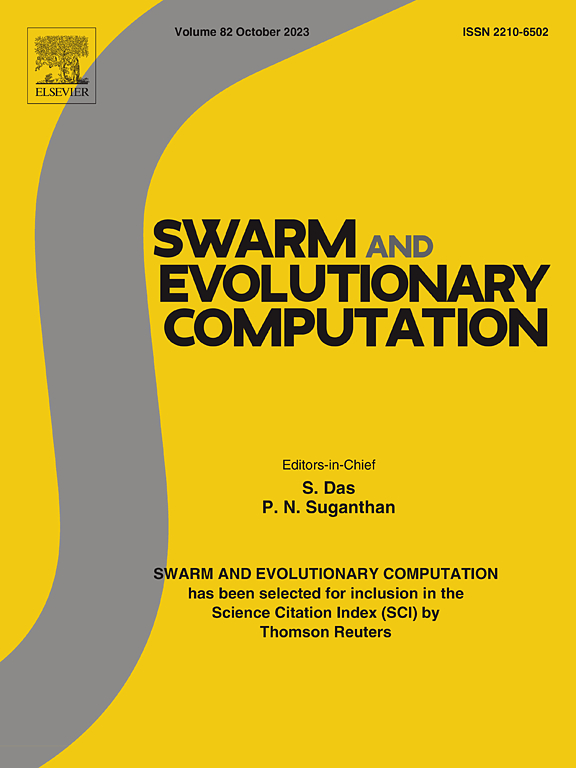基于双空间检测的动态多目标优化自适应响应算法
IF 8.5
1区 计算机科学
Q1 COMPUTER SCIENCE, ARTIFICIAL INTELLIGENCE
引用次数: 0
摘要
有效跟踪动态变化的pareto最优集或pareto最优前沿是动态多目标优化中的一个核心问题。大多数动态多目标进化算法(dmoea)实现了专门的响应机制来减轻环境变化的影响。为了解决不同变化严重程度对POS和POF的重要影响,我们提出了一种基于双空间检测的自适应响应算法,称为ARA-DMOEA。我们的方法结合了双空间变化严重性检测机制,量化POS和POF变化,动态地将变化分类为轻微或重大。基于这种实时评估,ARA-DMOEA自适应激活量身定制的响应策略。具体来说,当在任何一个空间中检测到重大变化时,门控循环单元(GRU)预测模型通过利用历史解决方案模式生成高质量的初始种群。对于较小的POS变化,质心导向差分预测(CDP)策略利用人口转移趋势来保持解决方案的多样性。对于较小的POF变化,随机解生成(RSG)策略通过扩大预测理想点和最低点周围的采样范围来增强多样性。根据双空间严重性检测,通过协同组合这些策略,ARA-DMOEA可以动态优化其对环境变化的响应。在一系列动态多目标问题上,与六种最先进的算法相比,ARA-DMOEA在具有更好的收敛性和多样性的同时,对环境变化具有更强的适应性。本文章由计算机程序翻译,如有差异,请以英文原文为准。
An adaptive response algorithm based on dual-space detection for dynamic multiobjective optimization
Efficiently tracking the dynamically changing Pareto-optimal set (POS) or Pareto-optimal front (POF) is a core task in dynamic multiobjective optimization. Most dynamic multi-objective evolutionary algorithms (DMOEAs) implement dedicated response mechanisms to mitigate the impact of environmental changes. To address the critical yet underexplored impact of varying change severities in both the POS and the POF, we propose an adaptive response algorithm based on dual-space detection, named ARA-DMOEA. Our approach incorporates a dual-space change severity detection mechanism that quantifies POS and POF variations, dynamically classifying changes as minor or significant. Based on this real-time assessment, ARA-DMOEA adaptively activates tailored response strategies. Specifically, when significant changes are detected in either space, a Gated Recurrent Unit (GRU) prediction model generates high-quality initial populations by leveraging historical solution patterns. For minor POS changes, a Centroid-guided Differential Prediction (CDP) strategy exploits population shift trends to maintain solution diversity. For minor POF changes, a Random Solution Generation (RSG) strategy enhances diversity by expanding sampling ranges around predicted ideal and nadir points. By synergistically combining these strategies according to dual-space severity detection, ARA-DMOEA dynamically optimizes its response to environmental shifts. In comparison with six state-of-the-art algorithms on a series of dynamic multiobjective problems, ARA-DMOEA demonstrates superior adaptability to environmental changes while achieving better convergence and diversity.
求助全文
通过发布文献求助,成功后即可免费获取论文全文。
去求助
来源期刊

Swarm and Evolutionary Computation
COMPUTER SCIENCE, ARTIFICIAL INTELLIGENCEC-COMPUTER SCIENCE, THEORY & METHODS
CiteScore
16.00
自引率
12.00%
发文量
169
期刊介绍:
Swarm and Evolutionary Computation is a pioneering peer-reviewed journal focused on the latest research and advancements in nature-inspired intelligent computation using swarm and evolutionary algorithms. It covers theoretical, experimental, and practical aspects of these paradigms and their hybrids, promoting interdisciplinary research. The journal prioritizes the publication of high-quality, original articles that push the boundaries of evolutionary computation and swarm intelligence. Additionally, it welcomes survey papers on current topics and novel applications. Topics of interest include but are not limited to: Genetic Algorithms, and Genetic Programming, Evolution Strategies, and Evolutionary Programming, Differential Evolution, Artificial Immune Systems, Particle Swarms, Ant Colony, Bacterial Foraging, Artificial Bees, Fireflies Algorithm, Harmony Search, Artificial Life, Digital Organisms, Estimation of Distribution Algorithms, Stochastic Diffusion Search, Quantum Computing, Nano Computing, Membrane Computing, Human-centric Computing, Hybridization of Algorithms, Memetic Computing, Autonomic Computing, Self-organizing systems, Combinatorial, Discrete, Binary, Constrained, Multi-objective, Multi-modal, Dynamic, and Large-scale Optimization.
 求助内容:
求助内容: 应助结果提醒方式:
应助结果提醒方式:


